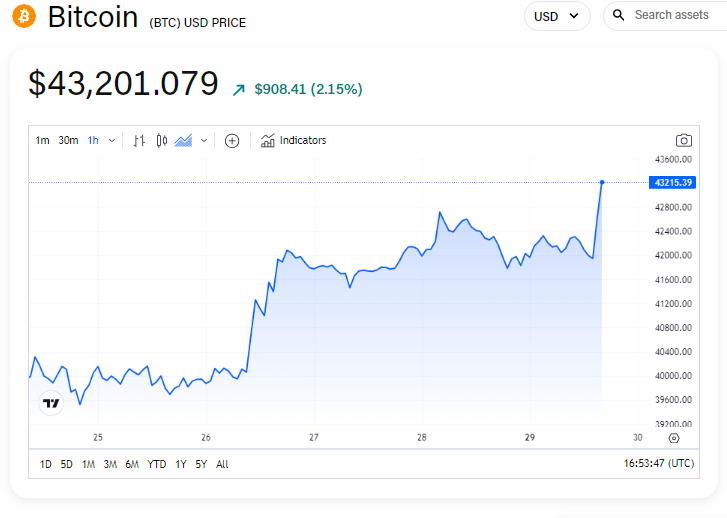Bitcoin Price Rebounds After Tumultuous ETF Approval
Bitcoin has seen its value go up, as Grayscale outflows subside and competitors earn massive ETF profits.
Although the value of bitcoin has been very erratic in the immediate weeks after the SEC’s approval of the Bitcoin ETFs, several factors in the market show a consistent trend of recovery.
The Bitcoin ETF approval has led to a chaotic period in an industry defined by volatility. On January 11, the community finally won an extended campaign to support this new financial instrument when the SEC gave the ETF a green light. However, although bitcoin’s price quickly shot up in the aftermath of this announcement, it cratered hard and fast soon after. This led to a great deal of speculation that the ETF was a sort of “poison pill” for the Bitcoin ecosystem — a bubble of hype that existed only for the short-term windfall of certain sellers. However, these fears are dissipating as the price is not only recuperating, but several of the factors related to the crash are disappearing themselves.
The core of bitcoin's crash is intrinsically tied up with the activities of several prominent ETF issuers. Grayscale, a leader in the ETF campaign, is a young and digital-native company with several distinct advantages over some of the more traditional investment firms wishing to enter the digital asset space. Although Grayscale enjoyed a natural position at the head of the ETF market despite having substantially lower assets than their main competitor, this has also made them a target. FTX, a shuttered exchange with massive debts, sold off their previous shares in Grayscale’s Bitcoin Trust (GBTC) all at once. This in turn triggered several billion dollars worth of GBTC shares being liquidated as well, and Grayscale sought to recuperate these losses by offloading more than $2B in bitcoin.
There were doubtlessly other factors to bitcoin’s price decline here, but these massive losses still did their part to create the sense that the ETF hype bubble was all a mirage. And yet, the price has been recovering. When considering the entire month of January 2024, bitcoin has basically gone back to its starting position with some additional gains. The downswing for bitcoin took a bite out of a graph that had been ascending at breakneck speed, and that record is still intact; Bitcoin’s month-by-month growth levels are currently at the highest level since the 2021 bonanza. Analysts are already speculating about possible economic conditions that will impact Bitcoin moving forward, but we should consider some factors as to why this recovery even happened.
First of all, Grayscale took some fairly significant hits from the run on GBTC, but they have staunched the bleeding. Outflows of GBTC have slowed down from their initial highs, and Grayscale is also continuing to sell their ETF offerings to new customers. Across the board, all the other big issuers of the Bitcoin ETF have seen large net sales of these new products. Between Grayscale finally stabilizing its situation and the other firms seeing profits on the same pace as the initial approval spike, confidence in the Bitcoin industry as a whole has been rising. Indeed, it turns out that the proposed strategy of deliberately picking on Grayscale could be bearing fruit for several big competitors.
Grayscale has a substantial amount of bitcoin in its arsenal, and a vast array of contacts and know-how brought on by its central focus on the digital asset space. What it doesn’t have, compared to firms like BlackRock or Fidelity, are many billions of dollars or the household recognition as a traditional asset manager. And although it was noteworthy when BlackRock first began to squeak out a lead over Grayscale in terms of ETF market volume, both of these major firms have become serious contenders for the number one spot. Although neither BlackRock nor Fidelity finished the day of January 30 ahead of Grayscale in trading volume, they both surpassed it at different points. Grayscale has as of yet managed to hold onto its lead, and if it recovers fully it may jump back ahead yet again. Nevertheless, the competition has made the most of the leader’s momentary setback, and it’s anyone’s guess who could end up on top.
Signs of life like this have done a great deal to reassure investors worldwide that Bitcoin is still the same rising star. Several multibillion dollar firms are competing over the ETF market for the simple reason that there are billions to be made here, and it’ll take more than a few days of lost revenue to change that. Three of the issuers have even opened up a new advertising campaign, putting ads for their ETFs on Google. If the narrative that the ETF was a case of the “buy the rumor, sell the news” strategy was correct, then why would the ad campaigns start now? Business decisions like this are unequivocally a sign for renewed stability in the fledgling ETF market.
As is always the case in Bitcoin, there are reasons to believe that we won’t see an absolute price skyrocket in the near future. For example, although these moves in the ETF world are very promising for building hype, they are ultimately unrelated to Bitcoin’s use as Bitcoin, and that economy is continuing to suffer some liquidity issues. Still, the ETF has proven to be an ample buoy for supporting Bitcoin in 2023. Now that the most pessimistic forecasts about this new financial instrument have been proven false, it seems likely that all Bitcoiners will profit from a healthy ETF economy. We have every reason to believe that the first growing pains in the ETF are over, and what are we left with? The same old Bitcoin. The ETF is a tool for popularizing and aggrandizing the world’s best digital currency, but Bitcoin’s merits are its own. As the new year starts off in earnest, it seems clear that Bitcoin has a strong bedrock of support.







